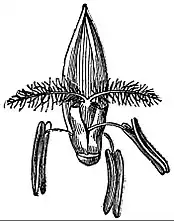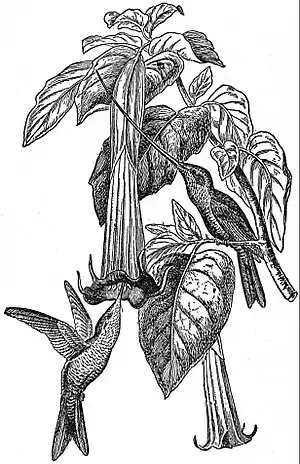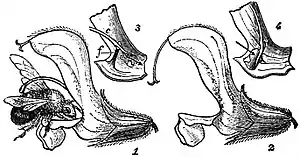4
POLLINATION
| b. | Bird-pollinated, Ornithophilae.—Humming-birds and honey suckers are agents of pollination in certain tropical plants; they visit the generally large and brightly-coloured flowers either for the honey which is secreted in considerable quantity or for the insects which have been attracted by the honey (fig. 7). | |||||||||||
| ||||||||||||
| c. | Snail or slug-pollinated flowers, Malacophilae.—In small flowers which are crowded at the same level or in flat flowers in which the stigmas and anthers project but little, slugs or snails creeping over their surface may transfer to the stigma the pollen which clings to the slimy foot. Such a transfer has been described In Various Aroids, Rohdea japonica (Liliaceae), and other plants. | |||||||||||
| ||||||||||||
| d. |
| |||||||||||
| A. | Pollen Flowers.—These offer only pollen to their visitors, as species of anemone, poppy, rose, tulip, &c. They are simple in structure and regular in form, and the generally abundant pollen is usually freely exposed. | |||||||||||
| B. | Nectar Flowers.—These contain nectar and include the following groups:— | |||||||||||
| 1. | Flowers with exposed nectar, readily visible and accessible to all visitors. These are very simple, open and generally regular flowers, white, greenish-yellow or yellow in colour and are chiefly visited by insects with a short proboscis, such as short-tongued wasps and flies, also beetles and more rarely bees. Examples are Umbelliferae as a family, saxifrages, holly, Acer, Rhamnus, Euonymus, Euphorbia, &c. | |||||||||||
| 2. | Flowers with nectar partly concealed and visible only in bright sunshine. The generally regular flowers are completely open only in bright sunshine, closing up into cups at other times. Such are most Cruciferae, buttercups, king-cup (Caltha), Potentilla. White and yellow colours predominate and insects with a proboscis of medium length are the common pollinating agents, such as short-tongued bees. | |||||||||||
| 3. | Flowers with nectar concealed by pouches, hairs, &c. Regular flowers predominate, e.g. Geranium, Cardamine pratensis, mallows, Rubus, Oxalis, Epilobium, &c., but many species show more or less well-marked median symmetry (zygomorphism) as Euphrasia, Orchis, thyme, &c., and red, blue and violet are the usual colours. Long-tongued insects such as the honey-bee are the most frequent visitors. | |||||||||||
| 4. | Social flowers, whose nectar is concealed as in (3), but the flowers are grouped in heads which render them strikingly conspicuous, and several flowers can be simultaneously pollinated. Such are Compositae as a class, also Scabiosa, Armeria (sea-pink) and others. | |||||||||||
| ||||||||||||
| 5. | Hymenopterid flowers, which fall into the following groups: Bee-flowers proper, humble-bee flowers requiring a longer proboscis to reach the nectar, wasp-flowers such as fig-wort (Scrophularia nodosa) and ichneumon flowers such as tway-blade (Listera ovata).
| |||||||||||
- ↑ See A. Kerner, Plants and their Unbidden Guests.




